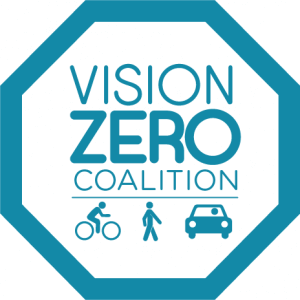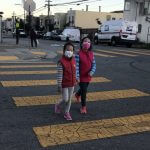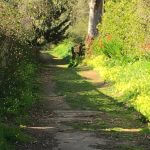Groups across San Francisco demand action for safe streets
Right now, we have the chance to strongly influence the City’s approach to safe streets. At play is the City’s next ‘Vision Zero Action Strategy’, the blueprint for what city agencies will do to improve traffic safety over the next two years.
That’s why Walk SF has been leading the Vision Zero Coalition – 35+ groups from across the entire city – in developing shared recommendations for the next Strategy.
The letter below was sent from the Vision Zero Coalition to SFMTA Director Jeffrey Tumlin, as SFMTA is the lead agency for Vision Zero.
Dear Director Tumlin,
Together as community-based organizations, nonprofits, and civic groups from across the city, the Vision Zero Coalition and our allied organizations want to extend our gratitude to you for your deep commitment to Vision Zero and willingness to bring bold solutions to bear for safe streets. We also want to recognize the years of hard work and dedication by SFMTA staff spearheading so many Vision Zero policies, projects, and programs. Thank you.
As the City begins to draft its next two-year Vision Zero Action Strategy, we want to share our recommendations to accelerate progress toward ending severe and fatal crashes.
For San Francisco to see a notable reduction in the number of people being killed and severely injured in traffic crashes in the next two years’ time will require a highly-focused approach.
The 2019 Vision Zero Action Strategy included more than 50 actions, the majority which had the SFMTA as the lead agency. We fear this spreads SFMTA’s efforts too thin, and won’t yield the results needed. The next Strategy must prioritize actions based on how much they will contribute to key outcomes at a meaningful scale. These top actions must then get as much attention and as many resources as possible.
A Highly-Focused, Outcomes-Based Approach
With speed as the #1 contributor to severe and fatal crashes in San Francisco, we believe actions that are proven to reduce average and high-risk speeds should rise to the top in the next Vision Zero Action Strategy.
Lowering speeds is the most powerful lever in getting to Vision Zero. If the next Vision Zero Action Strategy can bring speed reduction into focus, we will see a change in the right direction.
The other top five contributors to severe and fatal crashes must also be considered when prioritizing actions within the Vision Zero Action Strategy. These include violating the pedestrian right-of-way in a crosswalk, running red lights, running stop signs, and failure to yield while turning. This is why we believe priority actions should be considered based on how much they will quickly contribute to safe crossings.
And across-the-board, actions must be prioritized based on equity. The 2019 Vision Zero Action Strategy shows the disproportionate toll of traffic crashes: seniors; people with disabilities; people of color; people walking and biking; communities with high concentrations of low-income and non-English speaking residents and immigrants. Equity is the most important criteria in determining what’s on the “must do” list – and how aggressive to be in redesigning and enforcing safe streets. Children and families are also essential to consider with equity.
With time of the essence and SFMTA’s severe budget challenges, we also know an additional criteria must be those actions that are the fastest and cheapest to get on the ground at a meaningful scale.
Our Recommended Priority Actions
In light of these proposed criteria, we assessed the actions in the 2019 Vision Zero Action Strategy to determine which to recommend prioritizing in the next Strategy.
From the 2019 Strategy:
The Vision Zero Quick Build program. There are 168 miles of high-injury streets, and as of October 2020, 86 miles (51%) were not yet in any stage of planning or completion of safety improvements. The Vision Zero Quick Build program is the way to bridge this gap quickly. We know that this new approach is bringing significant safety improvements to life in months, not years – and is a much less expensive approach than traditional capital projects.
SFMTA’s recent analysis of the Quick Build project on Taylor Street shows this is right on-point. Vehicle speeds, especially high-risk speeds, notably decreased. The number of drivers yielding to pedestrians notably increased, and close calls plummeted.
Meanwhile, the only way bicycling will become a viable option for many more people is by creating lanes where all ages and abilities can feel safe. Protected bike lanes are how this can happen. The City is currently completing its mid-2019 commitment to install 20 miles of protected bike lanes within two years.
⇒ Complete Quick Build projects on 12% of the total miles of the high-injury network each year for 2021-2023 (approximately 20 miles per year). This includes 10 miles per year of protected bike infrastructure.
Intersection safety improvements. In the 2019 Strategy, there was an action to complete signal timing and intersection crossing upgrades at all intersections on the high-injury network. We know these upgrades are incredibly important for Vision Zero. Leading pedestrian intervals can reduce pedestrian-vehicle collisions by as much as 60%. Giving people more time to cross, plus timing lights to limit drivers’ ability to speed are all proven and inexpensive strategies to keep people safe. This action had a five year timeline in the 2019 Strategy. This must be accelerated given how many people are being hit and killed in the crosswalk.
In the 2019 Strategy, there were no actions related to daylighting and high-visibility crosswalks. Daylighting reduces crashes by up to 30% by creating clear sight lines at intersections. High-visibility continental crosswalks increase the likelihood of a driver yielding to a pedestrian by 30-40%. Both solutions are also fast and affordable to implement and as they are layered, it will make a real difference for safety. SFMTA has made progress with both, but these are needed comprehensively on the high-injury network now.
⇒ Complete all signal upgrades, continental crosswalks, and daylighting on the high-injury network within 2 years.
Left turn calming. With 40% of all traffic fatalities in 2019 involving a left turning driver, the Strategy must go big with this low-cost solution. At intersections in New York City with left turn calming, pedestrian injuries have decreased by 20%. Because left turn calming both reduces the speed that drivers go as they take the turn plus gives drivers better visibility of the crosswalk, it supports two of the top criteria.
⇒ Complete installation of ‘left turn calming’ at 25% of eligible high-injury intersections in Year One, and 50% in Year Two.
We also identified actions that were missing from the 2019 Strategy we believe must be priorities in the next one. These include:
A network of car-free and low-traffic streets. The leading Vision Zero cities worldwide have significant amounts of car-free and low-traffic spaces. Because of Slow Streets and car-free JFK Drive, Shelley Drive, and the Lower Great Highway, San Francisco is now in a position to establish a permanent and meaningful network of streets where people are prioritized. We need a vision and plan for realizing this, which will serve our city well in post-COVID recovery and indefinitely.
⇒ Design, legislate and implement a permanent network of 50 miles of Slow Streets and car-free streets within two years.
Better harness technology now to reduce dangerous driving behaviors. Despite running red lights being one of the most dangerous driving behaviors, the red light camera program is limited in scope. San Francisco currently has red light cameras at only 13 intersections; SFMTA committed to add 8 more by the end of 2022. We need a red light camera program that really shifts driver behavior to protect all road users.
⇒ Complete a red light camera program assessment and report by mid-2022 that includes how the program will be expanded by 2024.
A comprehensive speed management plan. Right now, there is no publicly available data or analysis on where speed is the biggest problem. There is also no inventory of existing speed-slowing efforts or assessment of the effectiveness of these efforts.
We know there is a significant backlog for installing important, already-approved traffic calming improvements like speed humps and tables. (As of November, 250 awaited construction by the Department of Public Works and we believe this backlog still exists. This will hold up Vision Zero progress if not addressed.) We need an outcomes-focused, transparent program that shows a strategic path to calmer streets, and tees up the City for success once legislation passes for the transformative policies described below (automated enforcement and urban speed limit setting).
⇒ Develop a comprehensive speed management plan by mid-2022.
Transformative Policies and Transit-First
In addition to those priority actions that can make a meaningful difference within two years’ time, we support the continued pursuit of the transformative policies included in the 2019 Vision Zero Action Strategy. These include: automated enforcement, urban speed limit setting, local regulation of transportation network companies, and pricing and reducing vehicle miles traveled. Given the timeline for any one of these policies to be realized, though, it again illustrates how much attention must be paid to what can happen now at a meaningful scale.
Finally, we want to emphasize that achieving Vision Zero, robust Muni service, and the City’s sustainable mode shift goals are mutually reinforcing. This deep interconnectedness – and the incredible impact these together have on health, equity, climate, and the economy – should be reflected in the next Strategy’s approach and aggressiveness.
The Vision Zero Coalition commends the substantial work the SFMTA has put into making the streets of San Francisco safer for everyone. We look forward to engaging in the creation and implementation of the next Vision Zero Action Strategy. We are here to support the City’s efforts in any way possible.
Sincerely,
The undersigned Vision Zero Coalition members and allied organizations
Bayview Hunters Point Mobilization for Adolescent Growth in our Communities (BMAGIC)
CC Puede
Central City SRO Collaborative
Chinatown Community Development Center
Dogpatch Neighborhood Association – Executive Committee
Duboce Triangle Neighborhood Association
East Cut Community Benefit District
Friends of Monterey Blvd
Hayes Valley Neighborhood Association
India Basin Neighborhood Association
Inner Sunset Park Neighbors
La Voz Latina
Livable City
Lower Haight Merchants and Neighbors Association (LoHaMNA)
North of Panhandle Neighborhood Association (NOPNA)
Potrero Boosters Neighborhood Association Executive Committee
Richmond Family Transportation Network
San Francisco Bicycle Coalition
San Francisco Interfaith Council
San Francisco Marin Medical Society
San Francisco Transit Riders
San Francisco Housing Action Coalition
San Francisco PTA, Second District of California State PTA (CAPTA)
South Beach | Rincon | Mission Bay Neighborhood Association Board of Directors
South of Market Community Action Network (SOMCAN)
St. Francis Square Cooperative
Tenderloin Housing Clinic
Tenderloin Neighborhood Development Corporation
TLCBD Safe Passage
Yerba Buena Community Benefit District (YBCBD)
Walk San Francisco
cc:
All 13 city agencies committed to Vision Zero:
Honorable Mayor London Breed City of San Francisco
SF Board of Supervisors
SFMTA Board of Directors
Nicole Bohn, Mayor’s Office on Disability Director
Chesa Boudin, District Attorney
Director Tilly Chang, SF County Transportation Authority Director
Carmen Chu, Office of the City Administrator
Director Grant Colfax, SF Department of Public Health
Director Alaric Degrafinried, SF Public Works Director
General Manager Phil Ginsberg, Recreation and Parks Department
Director Rich Hillis, SF Planning Department City Administrator
Superintendent Vincent Matthews, San Francisco Unified School District
Chief Jeanine Nicholson, San Francisco Fire Department
Director Deborah Raphael, SF Department of the Environment
Chief William Scott, San Francisco Police Department
Want to use your voice to urge the City to do more for safe streets? Take the SFMTA’s survey on the next Vision Zero Action Strategy by March 5 (Spanish, Chinese, and Tagalog surveys are also available here).
If you’re from a group interested in signing onto this letter, please contact brian@walksf.org.
Walk San Francisco leads the Vision Zero Coalition, which includes more than 35 community-based organizations, nonprofits, and civic groups representing communities across the city, and especially those most impacted by traffic deaths, including low-income communities and communities of color, seniors, and people with disabilities. The Vision Zero Coalition works to hold the City accountable in its commitment to end severe and fatal traffic crashes by 2024.
Banner image: William McLeod from the 2019 World Day of Remembrance for Road Traffic Victims




